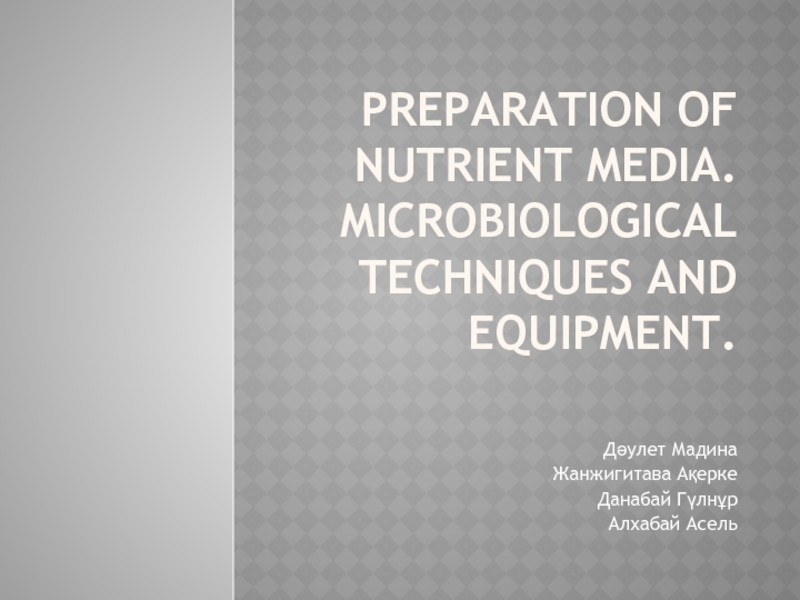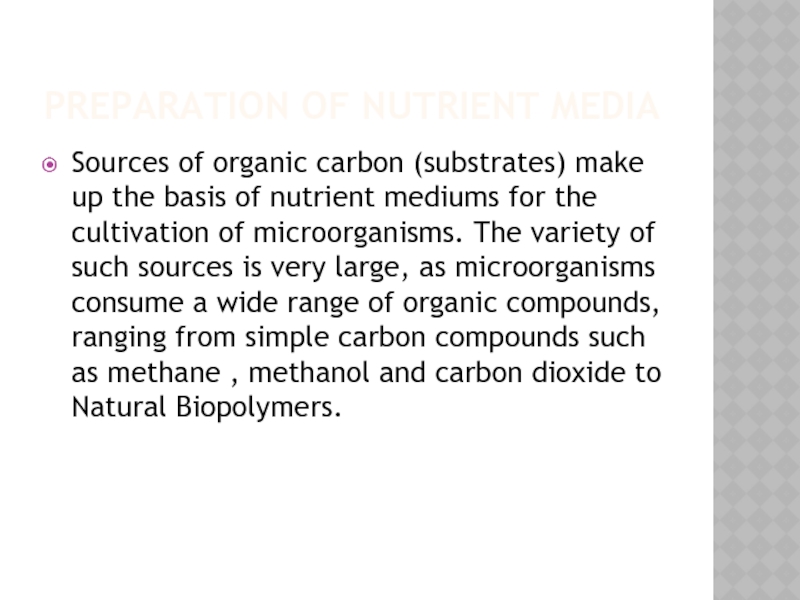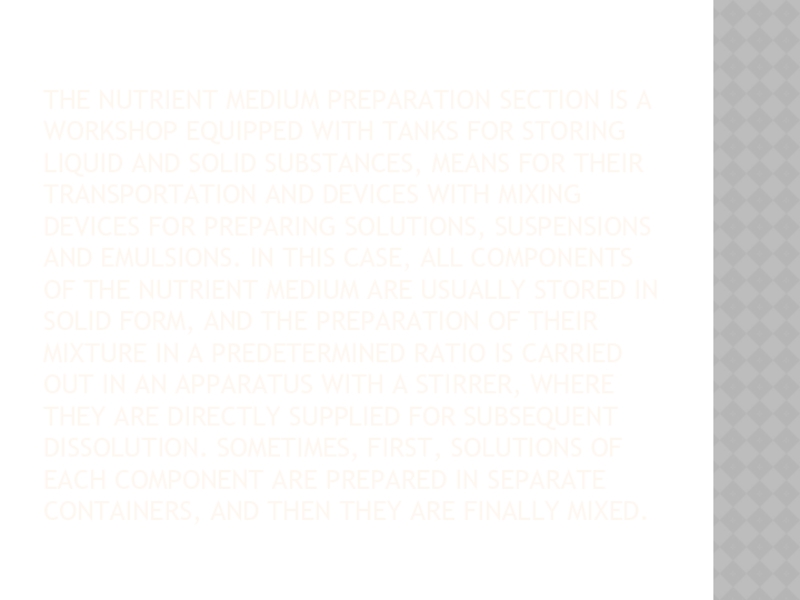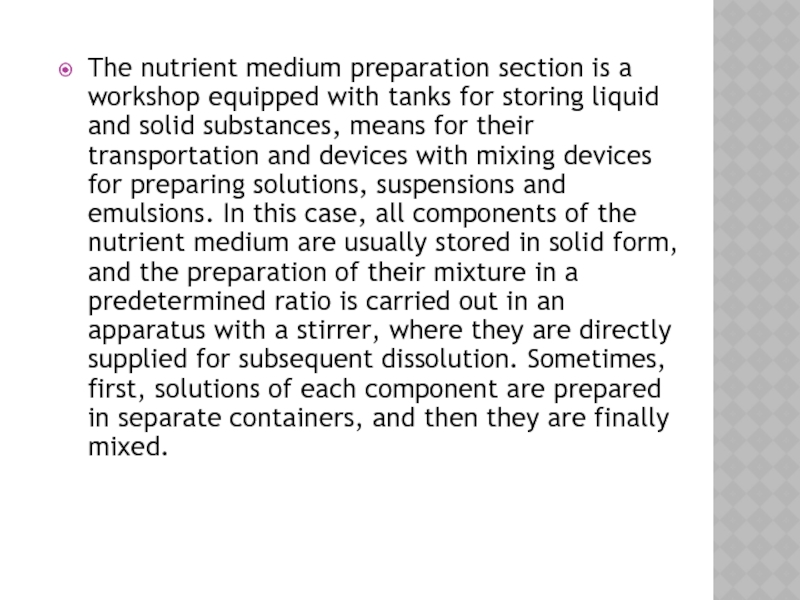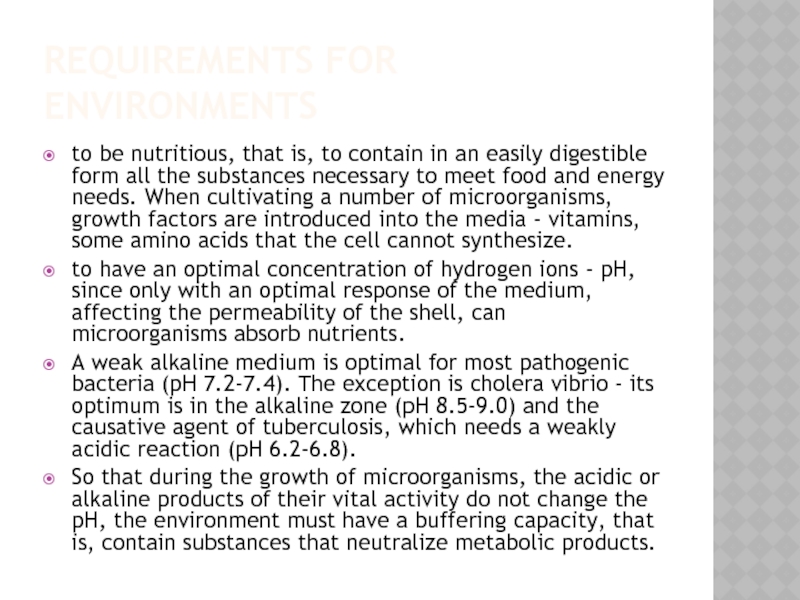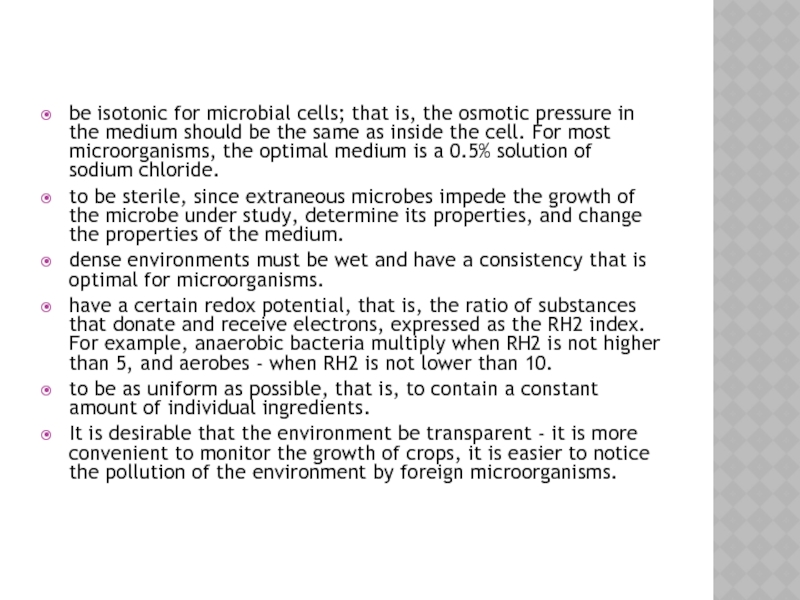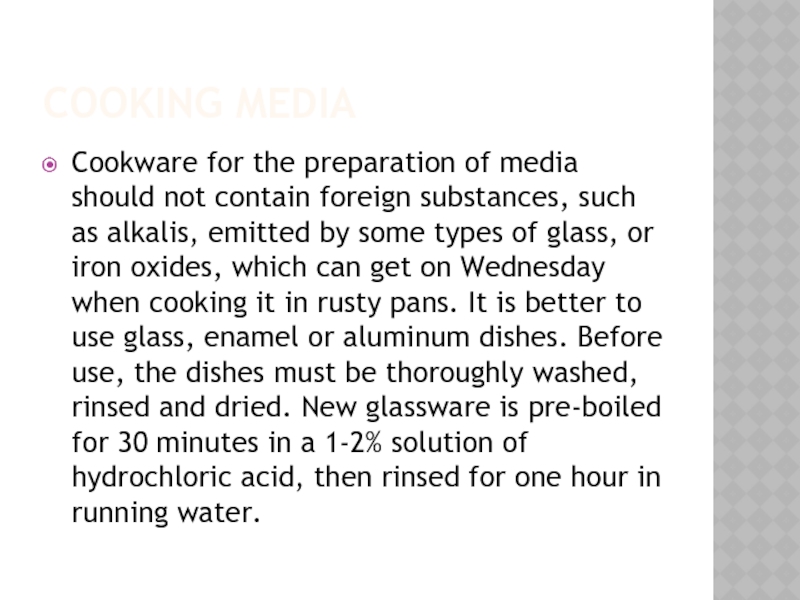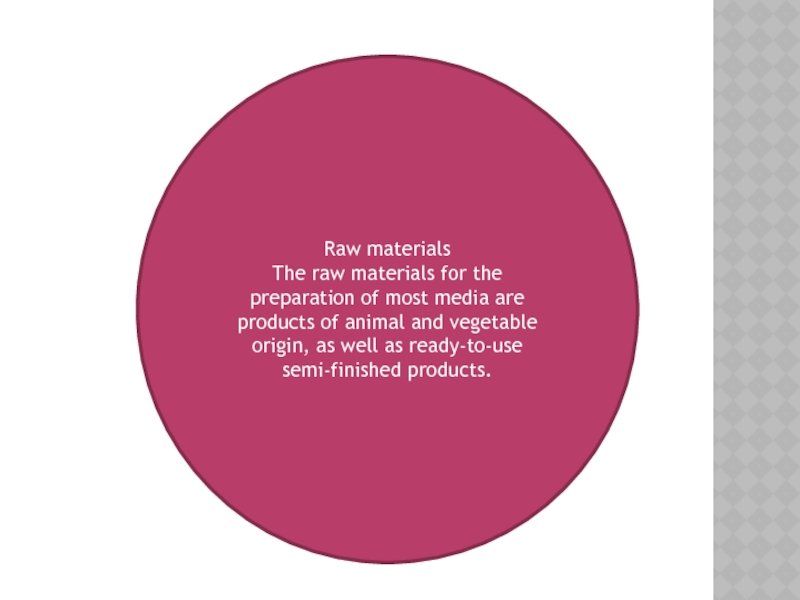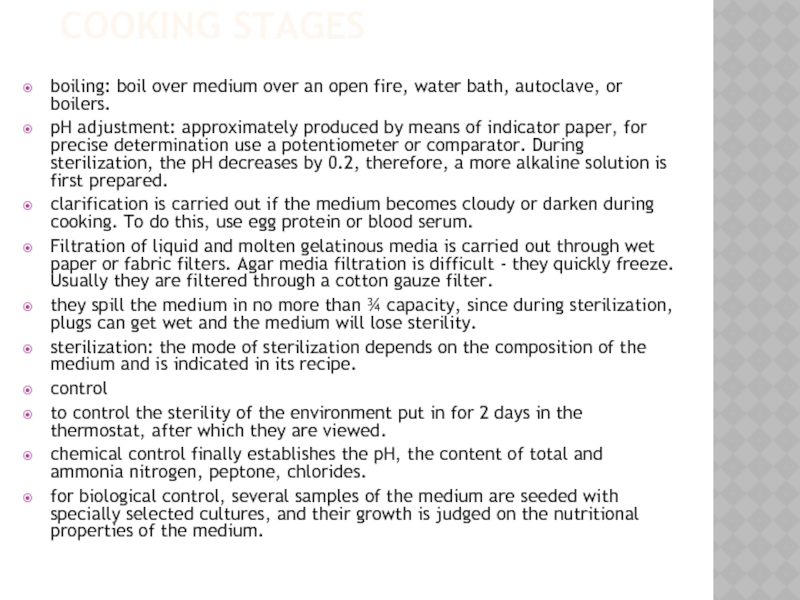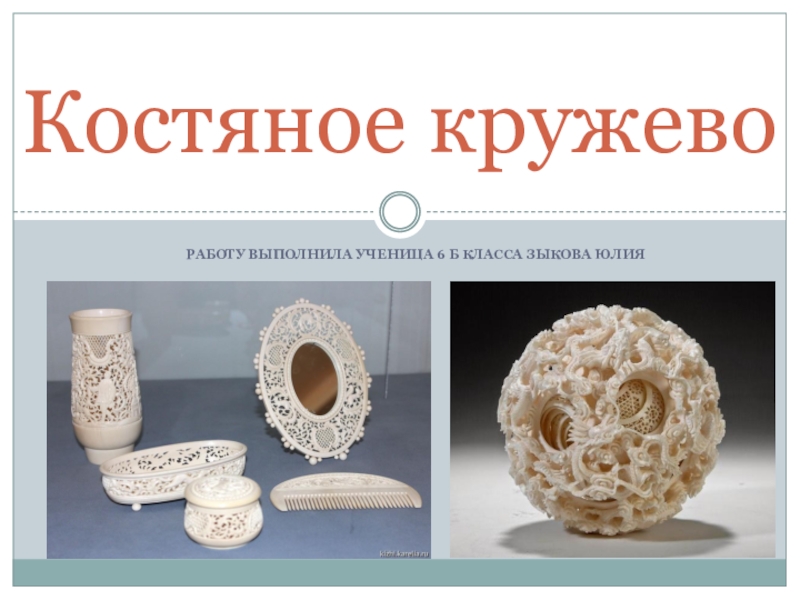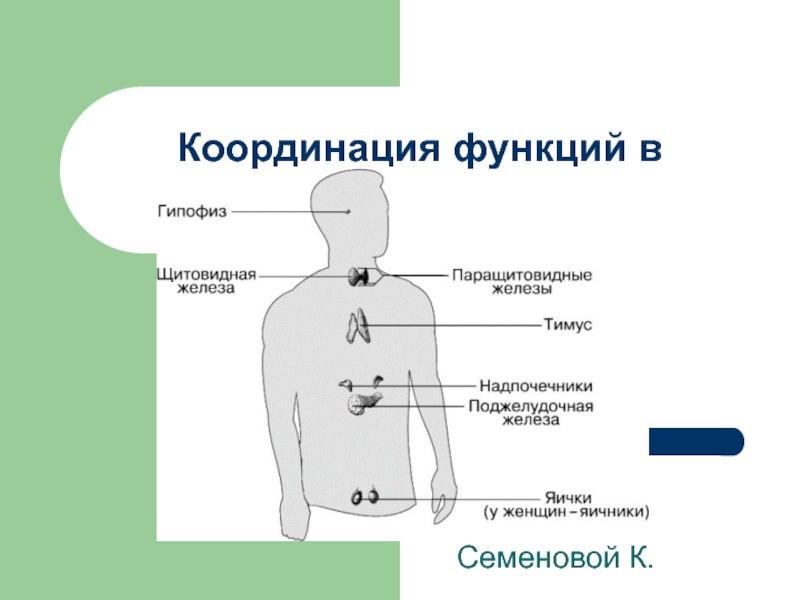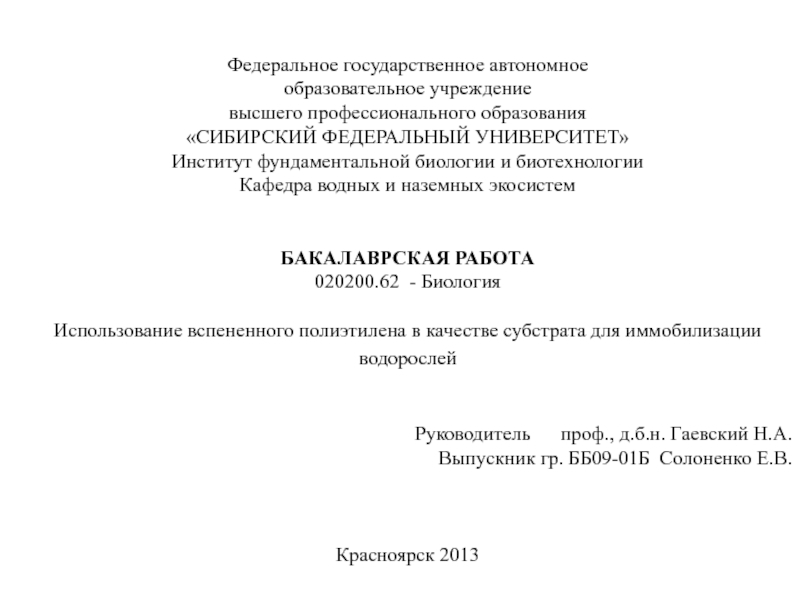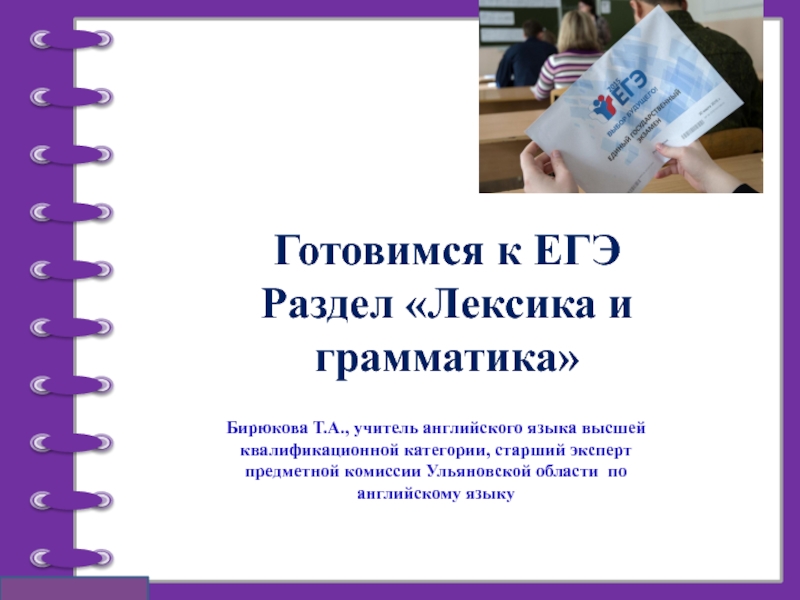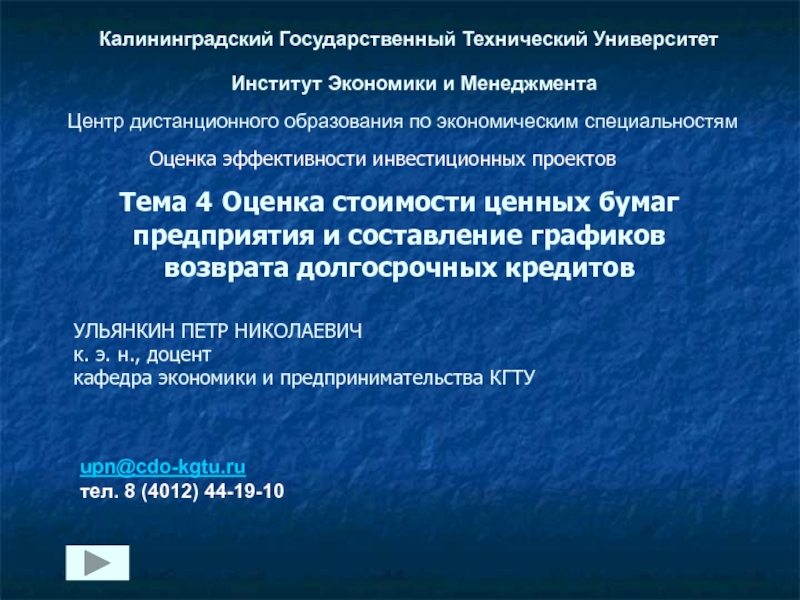Разделы презентаций
- Разное
- Английский язык
- Астрономия
- Алгебра
- Биология
- География
- Геометрия
- Детские презентации
- Информатика
- История
- Литература
- Математика
- Медицина
- Менеджмент
- Музыка
- МХК
- Немецкий язык
- ОБЖ
- Обществознание
- Окружающий мир
- Педагогика
- Русский язык
- Технология
- Физика
- Философия
- Химия
- Шаблоны, картинки для презентаций
- Экология
- Экономика
- Юриспруденция
Preparation of nutrient media. Microbiological techniques and equipment
Содержание
- 1. Preparation of nutrient media. Microbiological techniques and equipment
- 2. Preparation of nutrient mediaSources of organic carbon
- 3. The nutrient medium preparation section is a
- 4. The nutrient medium preparation section is a
- 5. Requirements for environmentsto be nutritious, that is,
- 6. be isotonic for microbial cells; that is,
- 7. Cooking mediaCookware for the preparation of media
- 8. Raw materialsThe raw materials for the preparation
- 9. Cooking stages boiling: boil over medium over
- 10. Скачать презентанцию
Preparation of nutrient mediaSources of organic carbon (substrates) make up the basis of nutrient mediums for the cultivation of microorganisms. The variety of such sources is very large, as microorganisms consume
Слайды и текст этой презентации
Слайд 1Preparation of nutrient media. Microbiological techniques and equipment.
Дәулет Мадина
Жанжигитава Ақерке
Данабай
Гүлнұр
Слайд 2Preparation of nutrient media
Sources of organic carbon (substrates) make up
the basis of nutrient mediums for the cultivation of microorganisms.
The variety of such sources is very large, as microorganisms consume a wide range of organic compounds, ranging from simple carbon compounds such as methane , methanol and carbon dioxide to Natural Biopolymers.Слайд 3The nutrient medium preparation section is a workshop equipped with
tanks for storing liquid and solid substances, means for their
transportation and devices with mixing devices for preparing solutions, suspensions and emulsions. In this case, all components of the nutrient medium are usually stored in solid form, and the preparation of their mixture in a predetermined ratio is carried out in an apparatus with a stirrer, where they are directly supplied for subsequent dissolution. Sometimes, first, solutions of each component are prepared in separate containers, and then they are finally mixed.Слайд 4The nutrient medium preparation section is a workshop equipped with
tanks for storing liquid and solid substances, means for their
transportation and devices with mixing devices for preparing solutions, suspensions and emulsions. In this case, all components of the nutrient medium are usually stored in solid form, and the preparation of their mixture in a predetermined ratio is carried out in an apparatus with a stirrer, where they are directly supplied for subsequent dissolution. Sometimes, first, solutions of each component are prepared in separate containers, and then they are finally mixed.Слайд 5Requirements for environments
to be nutritious, that is, to contain in
an easily digestible form all the substances necessary to meet
food and energy needs. When cultivating a number of microorganisms, growth factors are introduced into the media - vitamins, some amino acids that the cell cannot synthesize.to have an optimal concentration of hydrogen ions - pH, since only with an optimal response of the medium, affecting the permeability of the shell, can microorganisms absorb nutrients.
A weak alkaline medium is optimal for most pathogenic bacteria (pH 7.2-7.4). The exception is cholera vibrio - its optimum is in the alkaline zone (pH 8.5-9.0) and the causative agent of tuberculosis, which needs a weakly acidic reaction (pH 6.2-6.8).
So that during the growth of microorganisms, the acidic or alkaline products of their vital activity do not change the pH, the environment must have a buffering capacity, that is, contain substances that neutralize metabolic products.
Слайд 6be isotonic for microbial cells; that is, the osmotic pressure
in the medium should be the same as inside the
cell. For most microorganisms, the optimal medium is a 0.5% solution of sodium chloride.to be sterile, since extraneous microbes impede the growth of the microbe under study, determine its properties, and change the properties of the medium.
dense environments must be wet and have a consistency that is optimal for microorganisms.
have a certain redox potential, that is, the ratio of substances that donate and receive electrons, expressed as the RH2 index. For example, anaerobic bacteria multiply when RH2 is not higher than 5, and aerobes - when RH2 is not lower than 10.
to be as uniform as possible, that is, to contain a constant amount of individual ingredients.
It is desirable that the environment be transparent - it is more convenient to monitor the growth of crops, it is easier to notice the pollution of the environment by foreign microorganisms.
Слайд 7Cooking media
Cookware for the preparation of media should not contain
foreign substances, such as alkalis, emitted by some types of
glass, or iron oxides, which can get on Wednesday when cooking it in rusty pans. It is better to use glass, enamel or aluminum dishes. Before use, the dishes must be thoroughly washed, rinsed and dried. New glassware is pre-boiled for 30 minutes in a 1-2% solution of hydrochloric acid, then rinsed for one hour in running water.Слайд 8Raw materials
The raw materials for the preparation of most media
are products of animal and vegetable origin, as well as
ready-to-use semi-finished products.Слайд 9Cooking stages
boiling: boil over medium over an open fire, water
bath, autoclave, or boilers.
pH adjustment: approximately produced by means of
indicator paper, for precise determination use a potentiometer or comparator. During sterilization, the pH decreases by 0.2, therefore, a more alkaline solution is first prepared.clarification is carried out if the medium becomes cloudy or darken during cooking. To do this, use egg protein or blood serum.
Filtration of liquid and molten gelatinous media is carried out through wet paper or fabric filters. Agar media filtration is difficult - they quickly freeze. Usually they are filtered through a cotton gauze filter.
they spill the medium in no more than ¾ capacity, since during sterilization, plugs can get wet and the medium will lose sterility.
sterilization: the mode of sterilization depends on the composition of the medium and is indicated in its recipe.
control
to control the sterility of the environment put in for 2 days in the thermostat, after which they are viewed.
chemical control finally establishes the pH, the content of total and ammonia nitrogen, peptone, chlorides.
for biological control, several samples of the medium are seeded with specially selected cultures, and their growth is judged on the nutritional properties of the medium.
